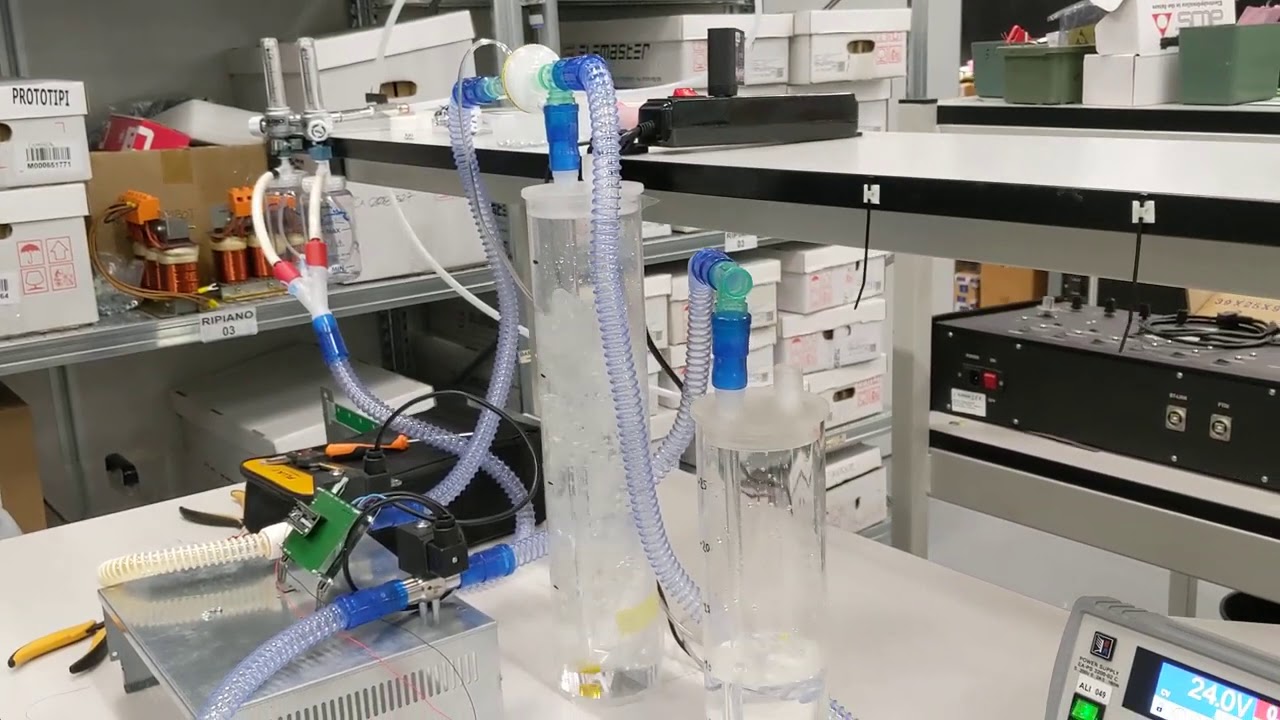
In many countries including France, hospitals are presently undergoing a shortage of artificial ventilators, which are essential to help those severely afflicted by COVID-19 and in need of assistance breathing. Despite the efforts of manufacturers, their production lines cannot respond to the current needs.
In order to mitigate this lack of supply, numerous projects to create new designs for simpler, quicker and cheaper to produce ventilators are blooming. Contributing to this endeavor, the DarkSide collaboration has put aside for the time being their hunt for dark matter so as to propose a newly model of mechanical ventilators.
According to the publication in preprint on arXiv and medRχiv, the “Mechanical Ventilator Milano” (MVM) has been specifically designed “to permit large scale production in a short time and at a limited cost, relying on off-the-shelf components, readily available worldwide”. The device is conforming to the UK’s Medicines and Healthcare products Regulatory Agency (MHRA) guidelines, in which they specifies in a document published in mid-March the prerequisites for such rapidly manufactured ventilator systems.
Originally his idea, Cristiano Galbiati, physicist at Princeton University and the Gran Sasso laboratory and speaker of the collaboration, has rapidly rallied his DarkSide colleagues, as well as physicists, engineers and doctors from around the globe, in order to conceive this ventilator. Being made by an international collaboration therefore able to work around the clock, the project is quickly moving ahead: a prototype was indeed built under ten days, and the first tests began on the 29th of March and should be soon completed.
Which raises a question: how particles physicists have been able to design a medical device in such a short time span? It turns out that the ventilator mechanical process is actually rather simple, whereas the software development for the control unit and the user interface is actually a far more sophisticated task. But it is also a domain in which experimental physicists quite excel at.
In addition to the software development, the DarkSide team at the APC laboratory* has been specifically working on the data analysis of the currently tested MVM prototype. The team was also task to develop the MVM website and online documentations, as well as partnership with manufacturers and hospitals in order to rapidly and locally produce the device once it is certified. Contacts were made with several companies, along with the French Ministère de l’Enseignement Supérieur et de la Recherche, providing promising leads.
Further information on the MVM website.
Links to the publications: arXiv / medRχiv
*Davide Franco, Alessandra Tonazzo, Florence Ardellier et Julie Rode.
In order to mitigate this lack of supply, numerous projects to create new designs for simpler, quicker and cheaper to produce ventilators are blooming. Contributing to this endeavor, the DarkSide collaboration has put aside for the time being their hunt for dark matter so as to propose a newly model of mechanical ventilators.
According to the publication in preprint on arXiv and medRχiv, the “Mechanical Ventilator Milano” (MVM) has been specifically designed “to permit large scale production in a short time and at a limited cost, relying on off-the-shelf components, readily available worldwide”. The device is conforming to the UK’s Medicines and Healthcare products Regulatory Agency (MHRA) guidelines, in which they specifies in a document published in mid-March the prerequisites for such rapidly manufactured ventilator systems.
Originally his idea, Cristiano Galbiati, physicist at Princeton University and the Gran Sasso laboratory and speaker of the collaboration, has rapidly rallied his DarkSide colleagues, as well as physicists, engineers and doctors from around the globe, in order to conceive this ventilator. Being made by an international collaboration therefore able to work around the clock, the project is quickly moving ahead: a prototype was indeed built under ten days, and the first tests began on the 29th of March and should be soon completed.
Which raises a question: how particles physicists have been able to design a medical device in such a short time span? It turns out that the ventilator mechanical process is actually rather simple, whereas the software development for the control unit and the user interface is actually a far more sophisticated task. But it is also a domain in which experimental physicists quite excel at.
In addition to the software development, the DarkSide team at the APC laboratory* has been specifically working on the data analysis of the currently tested MVM prototype. The team was also task to develop the MVM website and online documentations, as well as partnership with manufacturers and hospitals in order to rapidly and locally produce the device once it is certified. Contacts were made with several companies, along with the French Ministère de l’Enseignement Supérieur et de la Recherche, providing promising leads.
Further information on the MVM website.
Links to the publications: arXiv / medRχiv
*Davide Franco, Alessandra Tonazzo, Florence Ardellier et Julie Rode.
Services/Groupes:
- Particules
Objet de la publication:
Faits marquants projets
